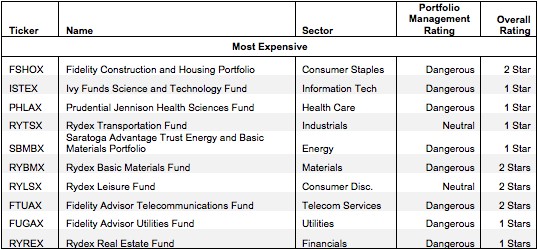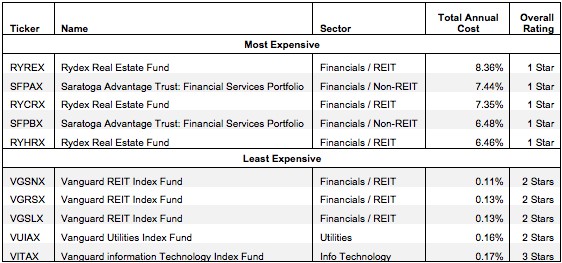Picking from the multitude of sector mutual funds is a daunting task. In any given sector there may be as many as 229 different mutual funds, and there are at least 631 mutual funds across all sectors.
Why are there so many mutual funds? The answer is: because mutual fund providers are making lots of money selling them. The number of mutual funds has little to do with serving investors’ best interests. Below are three red flags investors can use to avoid the worst mutual funds:
- Inadequate liquidity
- High fees
- Poor quality holdings
I address these red flags in order of difficulty. More details on the best & worst mutual funds by sector are here.
How To Avoid Mutual Funds with Inadequate Liquidity
This is the easiest issue to avoid, and my advice is simple. Avoid all mutual funds with less than $100 million in assets. Low asset levels tend to mean lower volume in the mutual fund and larger bid-ask spreads.
How To Avoid High Fees
Mutual funds should be cheap, but not all of them are.
To ensure you are paying at or below average fees, invest only in mutual funds with total annual costs (TAC) below 2.45%, which is the average TAC of the 6732 U.S. equity mutual funds I cover. If you weight the TACs by assets under management, then the average TAC is lower at 1.20%. A lower weighted average is a good sign that investors are putting money in the cheaper mutual funds.
Figure 1 shows the most and least expensive sector mutual funds in the U.S. equity universe based on total annual costs. Rydex Series Funds, provided by Guggenheim Investments, make up three of the top five most expensive sector funds, while Saratoga Advantage Trust provides the other two. Vanguard, on the other hand, provides all five of the cheapest sector mutual funds, all of which are index funds.
Figure 1: 5 Least and Most-Expensive Sector Mutual Funds
While costs among ETFs fall into a generally narrow range, mutual fund costs are more varied. The high costs of the most expensive mutual funds, sometimes above 8% annually, make it much harder for them to perform as well as the cheapest mutual funds.
However, investors need not pay high fees for good holdings. Vanguard Consumer Staples Index Fund (VCSAX) is my number one rated mutual fund overall, yet it has a low total annual cost of 0.17%.
On the other hand, the Vanguard REIT Index Funds (VGSNX, VGRSX, VGSLX) and Vanguard Utilities Index Fund (VUIAX) hold poor stocks, each getting a 2-star or Dangerous rating. And no matter how cheap a mutual fund, if it holds bad stocks, its performance will be bad.
This result highlights why investors should not choose mutual funds based only on price. The quality of holdings matters more than price.
How To Avoid Mutual Funds with the Worst Holdings
This step is by far the hardest, but it is also the most important because a mutual fund’s performance is determined more by its holdings than its costs. Figure 2 shows the mutual funds within each sector with the worst holdings or portfolio management ratings. The sectors are listed in descending order by overall rating as detailed in my 2Q13 Sector Ratings report.
Figure 2: Sector Mutual Funds with the Worst Holdings
My overall ratings on mutual funds are based primarily on my stock ratings of their holdings. My firm covers over 3000 stocks and is known for the due diligence done on each stock we cover.
Rydex Series Funds by Guggenheim Investments appear more often than any other providers in Figure 2, which means that they offer the most mutual funds with the worst holdings. Rydex Transportation Fund (RYTSX) and Rydex Real Estate Fund (RYREX) both receive a 1-star or Very Dangerous rating overall, while Rydex Basic Materials Fund (RYBMX) and Rydex Leisure Fund (RYLSX) receive 2-star or Dangerous ratings.
Note that no mutual funds with a dangerous portfolio management rating earn an overall rating better than two stars. These scores are consistent with my belief that the quality of a mutual fund is more about its holdings than its costs. If the mutual fund’s holdings are dangerous, then the overall rating cannot be better than dangerous because one cannot expect the performance of the fund to be any better than the performance of its holdings.
Still, while the Rydex Leisure Fund (RYLSX) receives a Neutral portfolio management rating, its high annual cost of 5.36% lowers its overall rating to a Dangerous or 2-stars. Even worse, the Rydex Transportation Fund also receives a Neutral portfolio rating, but its annual cost of 6% puts it in the 1-star or Very Dangerous category. Even mutual funds with more highly rated holdings must be considered Dangerous or Very Dangerous if their costs are too great. Both of these funds are in my top 10 most expensive of all sector mutual funds.
Find the mutual funds with the worst overall ratings on my mutual fund screener. More analysis of the Best Sector mutual funds is here.
The Danger Within
Buying a mutual fund without analyzing its holdings is like buying a stock without analyzing its business and finances. As Barron’s says, investors should know the Danger Within. Put another way, research on mutual fund holdings is necessary due diligence because a mutual fund’s performance is only as good as its holdings’ performance.
PERFORMANCE OF MUTUAL FUND’s HOLDINGs = PERFORMANCE OF MUTUAL FUND
Best & Worst Stocks In These Mutual Funds
Aspen Technology, Inc. (AZPN) is one of my least favorite stocks held by Ivy Funds Science and Technology Fund (ISTEX) and earns my Dangerous rating. Aspen has earned negative profits (NOPAT) for three years running now, losing over $96 million in 2010 and over $12 million last year. Its return on invested capital (ROIC) is also a dismal -3%. One would think investors would be wary of such a poorly performing business, but AZPN is ISTEX’s largest holding with a 7% allocation. Large allocations to Dangerous-rated stocks result in ISTEX’s Dangerous portfolio management rating and Very Dangerous rating overall.
Intel (INTC) is one of favorite holdings in Vanguard Information Technology Index Fund (VITAX), the only low-cost mutual fund in Figure 1 to get my 3-star rating. INTC gets my Very Attractive rating. Intel has more than doubled profits since 1998, with a NOPAT of $10.8 billion in 2012. Intel also boasts an impressive return on invested capital of 20%, in the top quintile of all companies I cover. And yet, Intel has a price to economic book value ratio of 0.75, implying that the market expects Intel’s profits to permanently decline by 25%. With a long history of turning a profit and making effective use of its capital, a permanent 25% decline in NOPAT seems unlikely. VITAX’s allocation to attractive stocks, such as its 3.6% allocation to INTC, earn it the top overall rating of my five cheapest mutual funds.
Sam McBride and André Rouillard contributed to this article
Disclosure: David Trainer, André and Sam McBride receive no compensation to write about any specific stock, sector, or theme.

